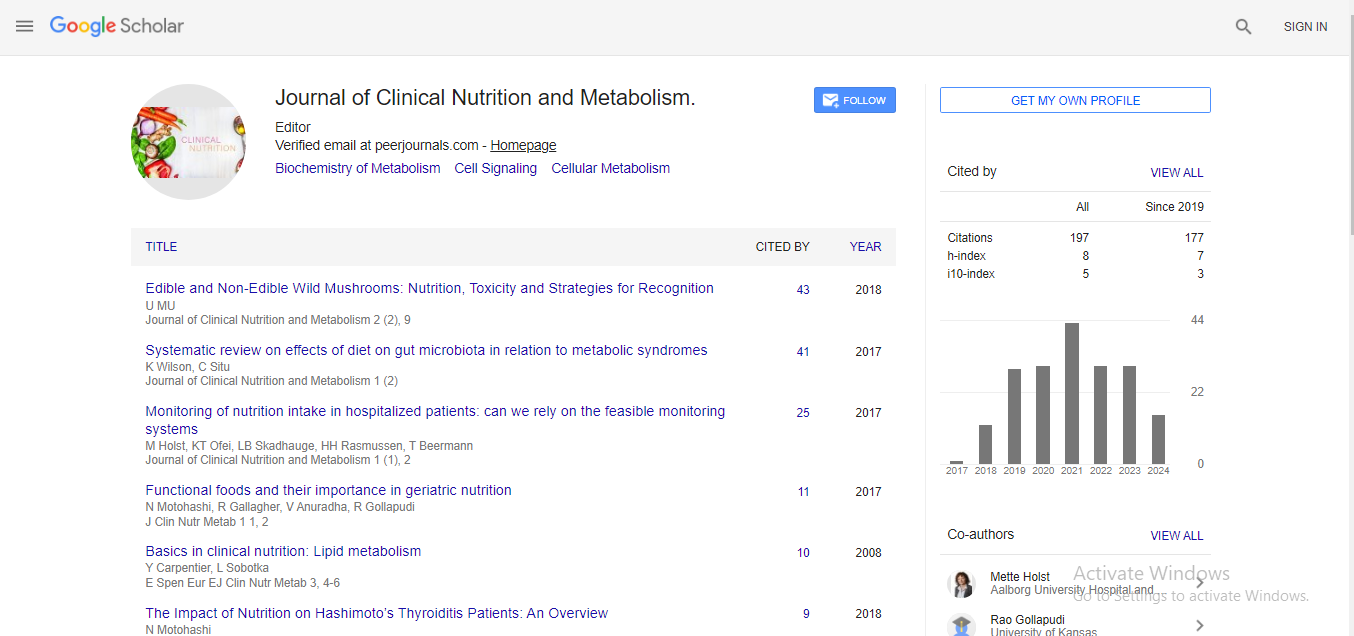Commentary, J Clin Nutr Metab Vol: 5 Issue: 5
Nutritional Screening and Malnutrition Assessment
Loris P*
Department of Medical and Surgical Sciences, University of Bologna, Italy
- *Corresponding Author:
- Loris P
Department of Medical and Surgical Sciences, University of Bologna, Italy
E-mail: loris_pn166@yahoo.com
Received Date: September 06, 2020; Accepted Date: September 25, 2021; Published Date: October 01, 2021
Citation: Loris P (2021) Nutritional Screening and Malnutrition Assessment. J Clin Nutr Metab 5:5. 128.
Copyright: © All articles published in Journal of Clinical Nutrition and Metabolism are the property of SciTechnol and is protected by copyright laws. Copyright © 2020, SciTechnol, All Rights Reserved.
Commentary
Malnutrition is an independent risk factor that negatively influences patients’ clinical outcomes, quality of life, body function, and autonomy. Early identification of patients at risk of malnutrition or who are malnourished is crucial in order to start a timely and adequate nutritional support. Nutritional risk screening, a simple and rapid first-line tool to detect patients at risk of malnutrition, should be performed systematically in patients at hospital admission. Patients with nutritional risk should subsequently undergo a more detailed nutritional assessment to identify and quantify specific nutritional problems. Such an assessment includes subjective and objective parameters such as medical history, current and past dietary intake (including energy and protein balance), physical examination and anthropometric measurements, functional and mental assessment, quality of life, medications, and laboratory values. Nutritional care plans should be developed in a multidisciplinary approach, and implemented to maintain and improve patients’ nutritional condition. Standardized nutritional management including systematic risk screening and assessment may also contribute to reduced healthcare costs. Adequate and timely implementation of nutritional support has been linked with favorable outcomes such as a decrease in length of hospital stay, reduced mortality, and reductions in the rate of severe complications, as well as improvements in quality of life and functional status. The aim of this review article is to provide a comprehensive overview of nutritional screening and assessment methods that can contribute to an effective and well-structured nutritional management (process cascade) of hospitalized patients. Malnutrition goes largely undiagnosed and untreated particularly among hospital patients. This is mainly due to lack of nutritional training and awareness among staff, but also to lack of proper protocols for screening, assessment and action.
Nutritional risk screening tools are very helpful in the daily routine to detect potential or manifest malnutrition in a timely manner. Such tools should be easy to use, quick, economical, standardized, and validated. Screening tools should be both sensitive and specific, and if possible, predictors of the success of the nutritional therapy. Nutritional screening should be part of a defined clinical protocol that results in a plan of action if the screening result is positive. Screening should be a simple and rapid process, which can be carried out by busy admitting nursing and medical staff. It should be sensitive enough to detect all or nearly all the patients at nutritional risk. There are some advantages in registering disease severity as well as nutritional status since the two interact. Moderate malnutrition may be more significant in the presence of severe disease. It should be capable of being scored numerically and audited, and should lead to appropriate and explicit action. Most screening tools address four basic questions: recent weight loss, recent food intake, current body mass index and disease severity or some other measure of predicting risk of malnutrition. In 2003, ESPEN published guidelines for nutrition screening in the community, in the hospital and among elderly in institutions. The usefulness of screening methods recommended is based on aspects of predictive validity, content validity, reliability and practicability. For adult patients in hospital it is suggested to use the Nutrition Risk Screening 2002. A score equal to or greater than 3 generates a nutrition plan in all cases. If the patient is at risk, but metabolic or functional problems prevent a standard plan being carried out, or if there is doubt as to whether the patient is at risk, a referral should be made to an expert for more detailed assessment.History and examination: to define all the factors leading to malnutrition and the likely natural history of the patient’s condition. Weight loss, appetite, gastrointestinal symptoms, fevers, medical and drug histories are all relevant. A diet history will also examine qualitative as well as quantitative aspects of diet to assess energy, protein and micronutrient intake. Impaired function should be revealed.
Disease status: this will be revealed not only by history, examination, and bedside measurements such as temperature, pulse rate and blood pressure, but also by laboratory tests of inflammation including full blood count, albumin and C-reactive protein. Additional nutrient losses from wounds, fistulae etc. will be assessed.
Functional assessment: the mental and physical dysfunction associated with malnutrition may be identified at the bedside. Muscle strength may be assessed qualitatively by the examiner or quantitatively using hand dynamometry, which correlates very well with clinical outcome in surgical patients. Ask the patient about exercise tolerance and breathing. Measure peak flow or FEV1. Using a validated mental scoring system e.g. POMS, mood status can be quantified and changes with treatment recorded.
Laboratory tests: laboratory tests as well as quantifying inflammation and disease severity these are valuable in identifying important changes in minerals e.g. K, Ca, Mg, P, Zn, Fe, as well as levels of vitamins and trace elements where the underlying disease may predispose to deficiencies.Fluid balance: this is an intrinsic part of nutritional assessment. Examine for dehydration or oedema. Monitor daily weight to record changes in fluid balance. Keep fluid balance charts and measure keratinise urea and electrolyte levels in blood as clinically indicated.
 Spanish
Spanish  Chinese
Chinese  Russian
Russian  German
German  French
French  Japanese
Japanese  Portuguese
Portuguese  Hindi
Hindi 